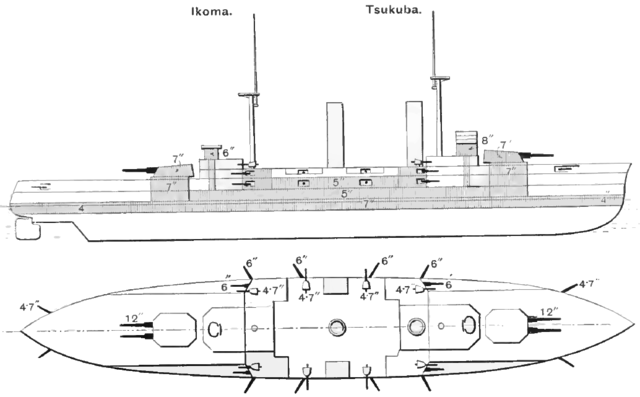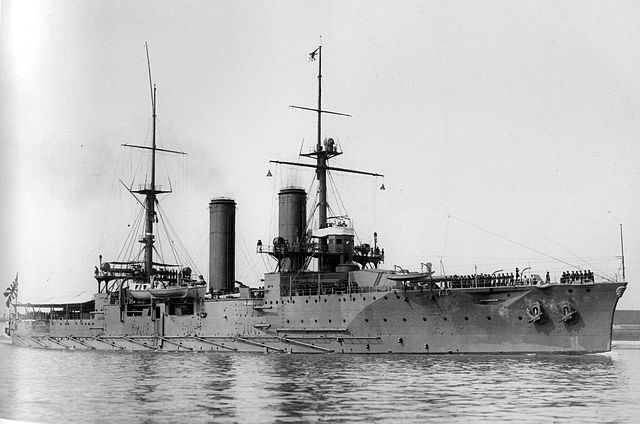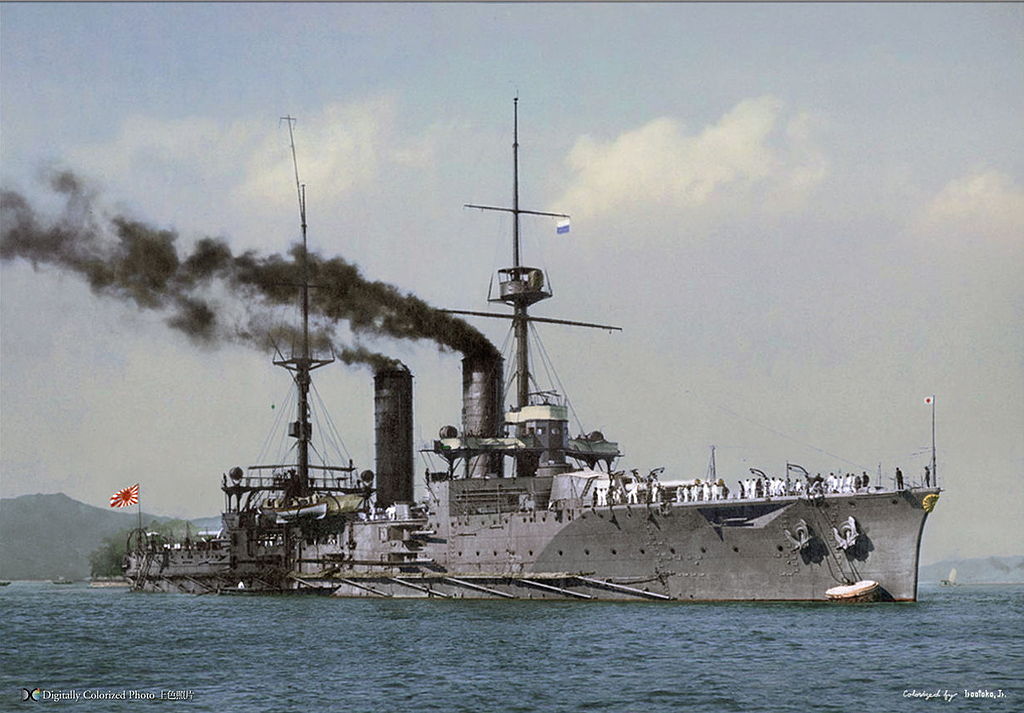Half-way between armoured cruisers and battlecruisers:
Tsukuba and Ikoma, massive ships armed with 12 in (305 mm) pieces were the result of a request from the navy after the observation of the Russians long-range gunnery at the Battle of the Yellow Sea, but also replacement of the Hatsuse and Yashima, blown up by mines in Port Arthur. After completion they were briefly the world’s most powerful cruisers in service (before the British Invincible class) and crucially the first capital ships entirely built in Japan on a Japanese design.
These ships seemed more akin armoured cruisers than battlecruisers but were not exempt of defects:
On completion, after a very fast construction (too much, given what was noted later), they were too slow and above all too weakly armed to be compared to their European equivalents, but were nevertheless classified as such by the General Staff.
Design
Prior to that class, the Japanese acquired perhaps their most heavily armoured cruisers to date, based on the popular Giuseppe Garibaldi-class design (a private venture by Ansaldo Nyd): The Kasuga class of 1904. They won recoignition and international attention in the Russo-Japanese War of 1905 and their actions drive towards the concept of battlecruiser. Engineers and designers under the naval staff supervision had this in mind when drawing the first sketches of the new ship. They were financed by the Japanese Diet temporary special budget of ¥48,465,631 affected to the 1904 War Naval Supplementary Program. They were aimed at taking part in the line of battle and overwhelming enemy cruisers, a notable change in IJN’s doctrine.
The Tsukuba class can be described summarily as bulkier, stubbier British Cressy-class armored cruisers. They diverged in having a clipper-style bow and modern Miyabara water-tube boilers, reduced to 20 (vs.30) to free some length for the new turrets and massive ammunition without much power loss. Armor thickness was preserved, but with an improved layout. The waterline armor belt (Krupp cemented armor) was 7 inches (178 mm) between turrets and only 4 inches (102 mm) on both ends. The upper strake of 5-inch (127 mm) armor extended between the barbettes and over the 6-inch casemates.
1-inch (25 mm) transverse bulkheads were later see as serious weaknesses in the ships’ protection. Main gun turrets front was 9.6 inch (244 mm) thick, sides 9-inch (229 mm) and 1.5-inch (38 mm) roof. Main barbettes were 7 in thicks and decks ranging from 1.5 in to 2 in (51 mm) on the deck slopes. The forward conning tower was 8 ins (203 mm), with a 3-inch roof. The major construction problem observed was their large metacentric height (4 feet 5 inches or 1.34 m). As a consequence they made bad gun platforms because of their very quick roll.
Powerplant
Both ships had two 4-cylinder VTE (vertical triple-expansion) steam engines, connected to single propeller shaft each. They were fed by 20 Miyabara boilers as stated above, claiming a working pressure of 16.8 kg/cm2 (1,648 kPa; 239 psi). These innovated by having a fuel oil spraying system onto the coal for extra power. In total these VTE developed 20,500 indicated horsepower (15,300 kW). Design speed was 20.5 knots (38.0 km/h; 23.6 mph) but during trials they reached 20.4 to 21.6 knots (37.8 to 40.0 km/h; 23.5 to 24.9 mph) with forced heating at 22,670–23,260 ihp (16,910–17,340 kW). Up to 1,911 long tons (1,942 t) coal was carried, and 160 long tons (160 t) of oil.

Tsukuba design – Brassey’s 1915.
Armament
Centerstage were the four 45-caliber 12-inch (41st Year Type) guns (305 mm). These battleship-standard guns were mounted in pairs with an hydraulically powered centerline turrets fore and aft. The Elevation/Depression was −3° to +23°. They could load ammo at an angle of +5°, up to +13° in exceptional conditions. They offered a 2,800 ft/s (850 m/s) muzzle velocity with AP shells, with a maximal range of 24,000 yd (22,000 m). Secondary armament comprised a set of 12 Elswick “Pattern GG” 45-caliber 6-inch (152 mm) guns. They were all mounted in armored casemates, the lower ones in the middle deck being condemned in case of bad weather.
They fired 100-pound (45.4 kg) AP shells at 2,706 feet per second (825 m/s) muzzle velocity. For close-quarter combat they were given 12 quick-firing (QF), 4.7-inch guns mounted in bow and stern casemates to deal with incoming TBs, the remainder being posted on decks, shielded, firing 12.5-pound (5.7 kg) projectiles at 2,359 feet per second (719 m/s). In addition they had four 40-caliber QF 12-pounder 12-cwt guns, mostly used for saluting purposes and four QF 3-pounder Hotchkiss guns. However the ships differred by having three three submerged torpedo tubes of different calibers, 533 mm for the broadside ones on the Ikoma.

Tsukuba in 1907
Career
Both ships were to be built at Yokosuka Naval Arsenal, named after famous Japanese mountains. But after fearing the nearby Russian 2nd and 3rd Pacific squadron coming from the Baltic Sea to raid the harbour, they were eventually ordered at the less-exposed Kure Naval Arsenal, which previously had little experience in this area. They needed brand new slipways, which were built. This gave considerable responsibility and experience to the yard, which became evtnually the main IJN yard and naval base until WW2. Tsukuba was completed in a record two years, whereas Ikoma took more time, the end of the war signalling a lower priority.
Lacking of modern cranes and heavy lifting equipments, the yard also had grave shortages of steel plates and rivets, which were imported from the US. Tsukuba suffered most from these problems. After commission in 1907, she left for the the US, articipating in the Jamestown Exposition Naval Review in May. Then she sailed for Europe, touring many ports and stopping in UK to be fitted with the lattest Vickers fire-control system, that calculated the firing data and communicated to the firing contols and turrets in real time. Crucially, both ships were reclassified as battlecruisers in 1912. Just before the war they had an armament overhaul, with ten 6-inch and eight 4.7-inch guns being installed in total.
Tsukuba served in wartime with the 1st South Seas Squadron. This unit was in charge of chasing the German East Asia Squadron in the Central Pacific. 7 October, she landed a party which occupied Ponape in the Caroline Islands. Ikoma joined the squadron in November and sailed for Fiji. She became a gunnery training ship in 1916. Both ships joined in 1917 the 2nd Division.
On January 14, 1917, the Tsukuba suffered a violent accidental explosion of one of its ammunition bunkers that tore its flanks, killing 305. She sank on the shoals of Yokosuka Bay and was later salvaged and broken up.
In 1919, Ikoma as a training ship for gunners, was rearmed with 10 x 152mm, 8 x 120 mm, 8 cm/40 3rd Year Type anti-aircraft (AA) guns, and 6 x 45 mm. She was re-rated as first class cruiser in 1921, disarmed in 1922 following the Washington treaty limitations, and stricken from the lists in 1924, after only 16 years of active life.
Both ships would remain strange hybrids, not powerful and fast enough to be considered as true battlecruisers, not armoured enough to be battleships, but certainly much too powerful to be considered as standard armored cruisers. They innovated in some area, but their rushed construction had some consequences.
Features (Kurama) |
|
| Displacement: 15 400t Fully Loaded | |
| Dimensions: 137.2 x 23 x 8 m | |
| Propulsion: 2 shafts VTE, 20 Miyabara boilers, 20,500 hp, 20.5 knots | |
| Armour: Belt 203 mm, see notes | |
| Crew: 844 | |
| Armament: 4 x 305, 12 x 152, 12 x 120, 4 x 45 mm, 2 x 40 mm AA, 3 TT 457mm sub. | |
Sources/read more
navypedia.org/ships/japan/jap_cr_ikoma.htm
naval-encyclopedia.com/ww1/pages/japan/marine_jap1914c.htm
naval-encyclopedia.com/ww1/pages/japan/tsukuba.html
https://en.wikipedia.org/wiki/Tsukuba-class_cruiser
Naval Warfare, 1815-1914
Cruisers and Battle Cruisers: An Illustrated History of Their Impact By Eric W. Osborne




 Latest Facebook Entry -
Latest Facebook Entry -  X(Tweeter) Naval Encyclopedia's deck archive
X(Tweeter) Naval Encyclopedia's deck archive Instagram (@navalencyc)
Instagram (@navalencyc)





 French Navy
French Navy Royal Navy
Royal Navy Russian Navy
Russian Navy Armada Espanola
Armada Espanola Austrian Navy
Austrian Navy K.u.K. Kriegsmarine
K.u.K. Kriegsmarine Dansk Marine
Dansk Marine Nautiko Hellenon
Nautiko Hellenon Koninklije Marine 1870
Koninklije Marine 1870 Marinha do Brasil
Marinha do Brasil Osmanlı Donanması
Osmanlı Donanması Marina Do Peru
Marina Do Peru Marinha do Portugal
Marinha do Portugal Regia Marina 1870
Regia Marina 1870 Nihhon Kaigun 1870
Nihhon Kaigun 1870 Preußische Marine 1870
Preußische Marine 1870 Russkiy Flot 1870
Russkiy Flot 1870 Svenska marinen
Svenska marinen Søværnet
Søværnet Union Navy
Union Navy Confederate Navy
Confederate Navy Armada de Argentina
Armada de Argentina Imperial Chinese Navy
Imperial Chinese Navy Marinha do Portugal
Marinha do Portugal Mexico
Mexico Kaiserliche Marine
Kaiserliche Marine 1898 US Navy
1898 US Navy Sovietskiy Flot
Sovietskiy Flot Royal Canadian Navy
Royal Canadian Navy Royal Australian Navy
Royal Australian Navy RNZN Fleet
RNZN Fleet Chinese Navy 1937
Chinese Navy 1937 Kriegsmarine
Kriegsmarine Chilean Navy
Chilean Navy Danish Navy
Danish Navy Finnish Navy
Finnish Navy Hellenic Navy
Hellenic Navy Polish Navy
Polish Navy Romanian Navy
Romanian Navy Turkish Navy
Turkish Navy Royal Yugoslav Navy
Royal Yugoslav Navy Royal Thai Navy
Royal Thai Navy Minor Navies
Minor Navies Albania
Albania Austria
Austria Belgium
Belgium Columbia
Columbia Costa Rica
Costa Rica Cuba
Cuba Czechoslovakia
Czechoslovakia Dominican Republic
Dominican Republic Haiti
Haiti Hungary
Hungary Honduras
Honduras Estonia
Estonia Iceland
Iceland Eire
Eire Equador
Equador Iran
Iran Iraq
Iraq Latvia
Latvia Liberia
Liberia Lithuania
Lithuania Mandchukuo
Mandchukuo Morocco
Morocco Nicaragua
Nicaragua Persia
Persia San Salvador
San Salvador Sarawak
Sarawak Uruguay
Uruguay Venezuela
Venezuela Zanzibar
Zanzibar Warsaw Pact Navies
Warsaw Pact Navies Bulgaria
Bulgaria Hungary
Hungary

 Bundesmarine
Bundesmarine Dutch Navy
Dutch Navy Hellenic Navy
Hellenic Navy Marina Militare
Marina Militare Yugoslav Navy
Yugoslav Navy Chinese Navy
Chinese Navy Indian Navy
Indian Navy Indonesian Navy
Indonesian Navy JMSDF
JMSDF North Korean Navy
North Korean Navy Pakistani Navy
Pakistani Navy Philippines Navy
Philippines Navy ROKN
ROKN Rep. of Singapore Navy
Rep. of Singapore Navy Taiwanese Navy
Taiwanese Navy IDF Navy
IDF Navy Saudi Navy
Saudi Navy Royal New Zealand Navy
Royal New Zealand Navy Egyptian Navy
Egyptian Navy South African Navy
South African Navy






























 Ukrainian Navy
Ukrainian Navy dbodesign
dbodesign